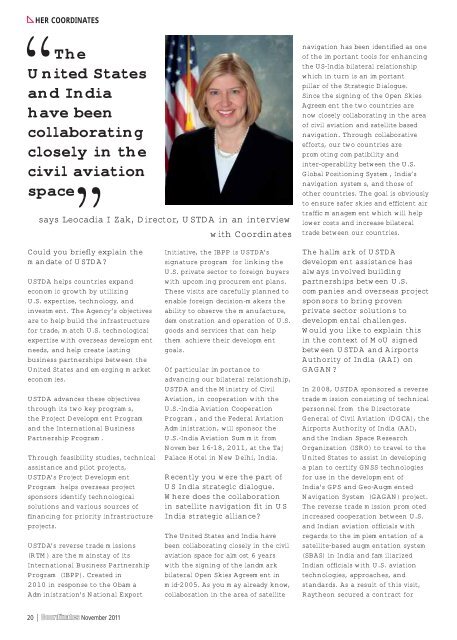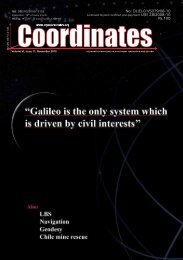Download - Coordinates
Download - Coordinates
Download - Coordinates
Create successful ePaper yourself
Turn your PDF publications into a flip-book with our unique Google optimized e-Paper software.
HER COORDINATES<br />
The<br />
United States<br />
and India<br />
have been<br />
collaborating<br />
closely in the<br />
civil aviation<br />
space<br />
says Leocadia I Zak, Director, USTDA in an interview<br />
with <strong>Coordinates</strong><br />
Could you briefl y explain the<br />
mandate of USTDA?<br />
USTDA helps countries expand<br />
economic growth by utilizing<br />
U.S. expertise, technology, and<br />
investment. The Agency’s objectives<br />
are to help build the infrastructure<br />
for trade, match U.S. technological<br />
expertise with overseas development<br />
needs, and help create lasting<br />
business partnerships between the<br />
United States and emerging market<br />
economies.<br />
USTDA advances these objectives<br />
through its two key programs,<br />
the Project Development Program<br />
and the International Business<br />
Partnership Program.<br />
Through feasibility studies, technical<br />
assistance and pilot projects,<br />
USTDA’s Project Development<br />
Program helps overseas project<br />
sponsors identify technological<br />
solutions and various sources of<br />
fi nancing for priority infrastructure<br />
projects.<br />
USTDA’s reverse trade missions<br />
(RTM) are the mainstay of its<br />
International Business Partnership<br />
Program (IBPP). Created in<br />
2010 in response to the Obama<br />
Administration’s National Export<br />
20 | <strong>Coordinates</strong> November 2011<br />
Initiative, the IBPP is USTDA’s<br />
signature program for linking the<br />
U.S. private sector to foreign buyers<br />
with upcoming procurement plans.<br />
These visits are carefully planned to<br />
enable foreign decision-makers the<br />
ability to observe the manufacture,<br />
demonstration and operation of U.S.<br />
goods and services that can help<br />
them achieve their development<br />
goals.<br />
Of particular importance to<br />
advancing our bilateral relationship,<br />
USTDA and the Ministry of Civil<br />
Aviation, in cooperation with the<br />
U.S.-India Aviation Cooperation<br />
Program, and the Federal Aviation<br />
Administration, will sponsor the<br />
U.S.-India Aviation Summit from<br />
November 16-18, 2011, at the Taj<br />
Palace Hotel in New Delhi, India.<br />
Recently you were the part of<br />
US India strategic dialogue.<br />
Where does the collaboration<br />
in satellite navigation fi t in US<br />
India strategic alliance?<br />
The United States and India have<br />
been collaborating closely in the civil<br />
aviation space for almost 6 years<br />
with the signing of the landmark<br />
bilateral Open Skies Agreement in<br />
mid-2005. As you may already know,<br />
collaboration in the area of satellite<br />
navigation has been identifi ed as one<br />
of the important tools for enhancing<br />
the US-India bilateral relationship<br />
which in turn is an important<br />
pillar of the Strategic Dialogue.<br />
Since the signing of the Open Skies<br />
Agreement the two countries are<br />
now closely collaborating in the area<br />
of civil aviation and satellite based<br />
navigation. Through collaborative<br />
efforts, our two countries are<br />
promoting compatibility and<br />
inter-operability between the U.S.<br />
Global Positioning System, India’s<br />
navigation systems, and those of<br />
other countries. The goal is obviously<br />
to ensure safer skies and effi cient air<br />
traffi c management which will help<br />
lower costs and increase bilateral<br />
trade between our countries.<br />
The hallmark of USTDA<br />
development assistance has<br />
always involved building<br />
partnerships between U.S.<br />
companies and overseas project<br />
sponsors to bring proven<br />
private sector solutions to<br />
developmental challenges.<br />
Would you like to explain this<br />
in the context of MoU signed<br />
between USTDA and Airports<br />
Authority of India (AAI) on<br />
GAGAN?<br />
In 2008, USTDA sponsored a reverse<br />
trade mission consisting of technical<br />
personnel from the Directorate<br />
General of Civil Aviation (DGCA), the<br />
Airports Authority of India (AAI),<br />
and the Indian Space Research<br />
Organization (ISRO) to travel to the<br />
United States to assist in developing<br />
a plan to certify GNSS technologies<br />
for use in the development of<br />
India’s GPS and Geo-Augmented<br />
Navigation System (GAGAN) project.<br />
The reverse trade mission promoted<br />
increased cooperation between U.S.<br />
and Indian aviation offi cials with<br />
regards to the implementation of a<br />
satellite-based augmentation system<br />
(SBAS) in India and familiarized<br />
Indian offi cials with U.S. aviation<br />
technologies, approaches, and<br />
standards. As a result of this visit,<br />
Raytheon secured a contract for

















